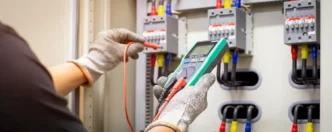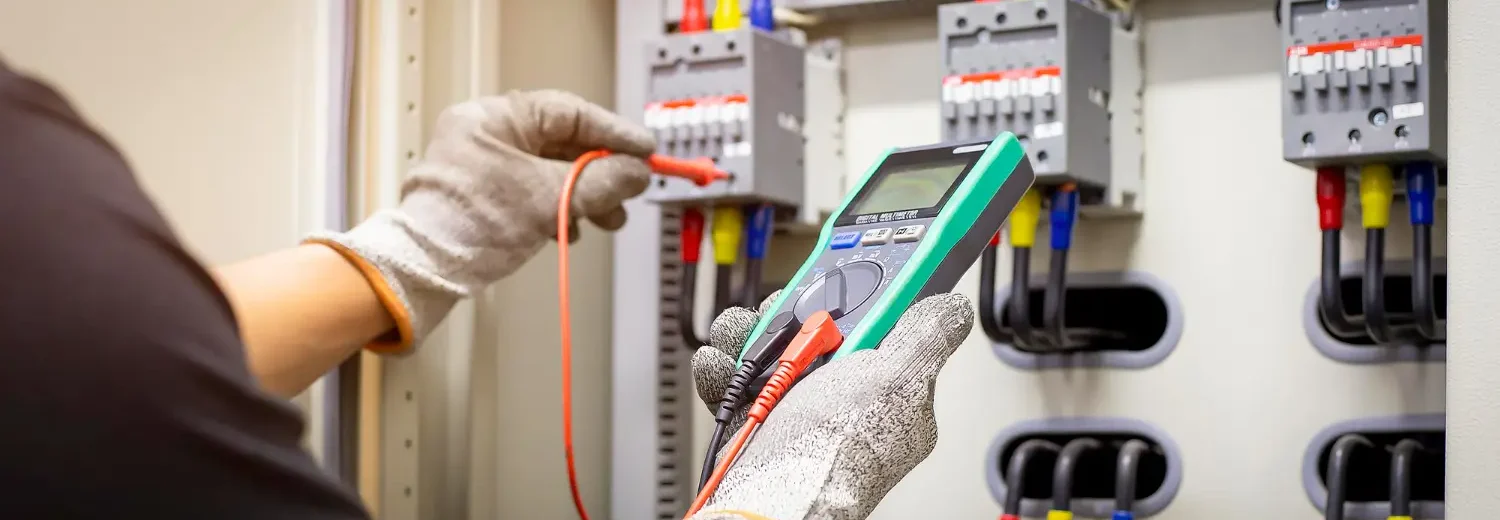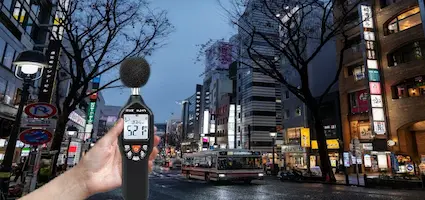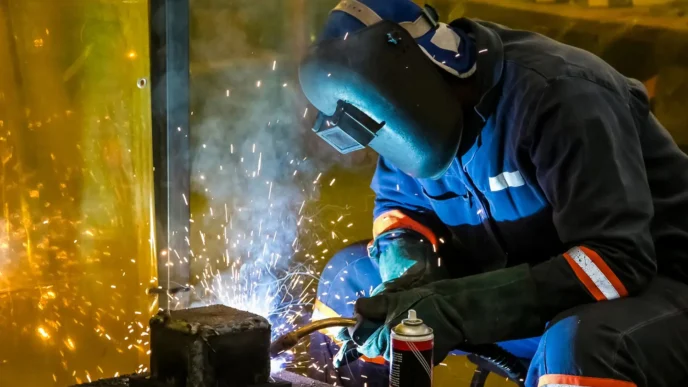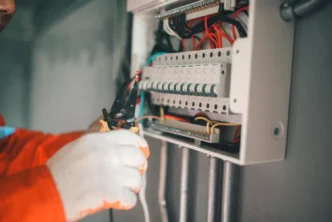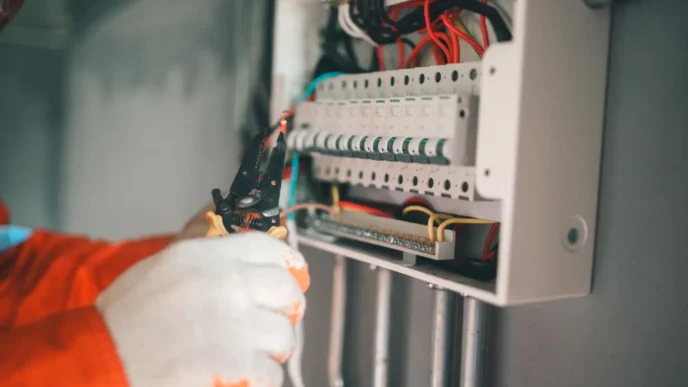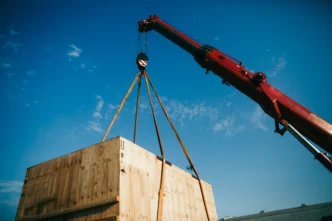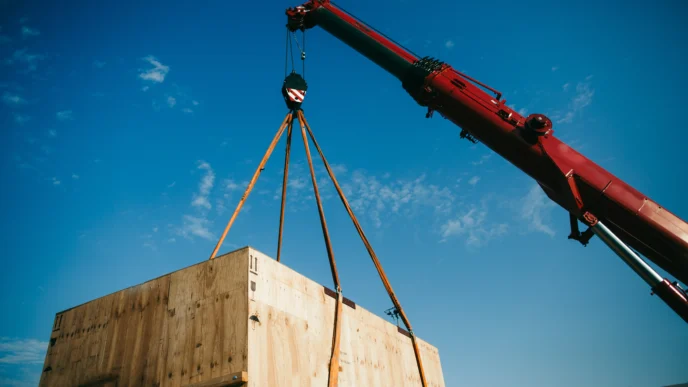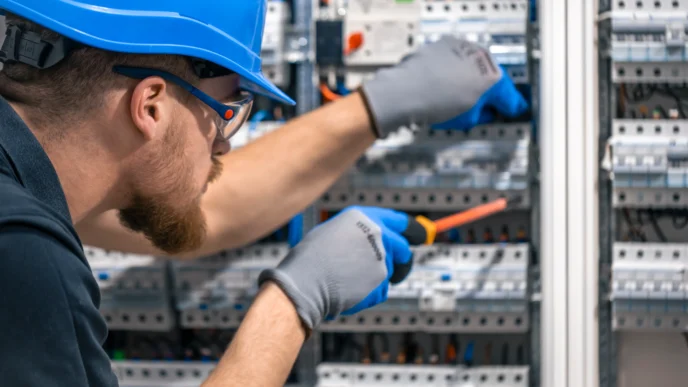Technical Name: NR 10 BASIC TRAINING COURSE SAFETY IN ELECTRICITY INSTALLATIONS AND SERVICES
Reference: 167222
We provide courses and training; We perform Translations and Versions in Technical Language: Portuguese, English, Spanish, French, Italian, Mandarin, German, Russian, Swedish, Dutch, Hindi, Japanese and consult to others.
What is the objective of the NR 10 Basic Course?
The NR 10 Basic Course aims to train workers who operate directly or indirectly with electricity, promoting a comprehensive understanding of electrical risks, control measures, and mandatory procedures established by the regulation. Thus, the training focuses on accident prevention, legal compliance, and reducing human errors in the workplace.
Therefore, this course is mandatory for any employee who comes into contact with electrical installations or services, even indirectly. It provides a solid technical foundation on de-energization, signage, risk analysis, use of PPE and collective protection equipment, while also emphasizing the importance of legal documentation in the safe management of electrical energy.
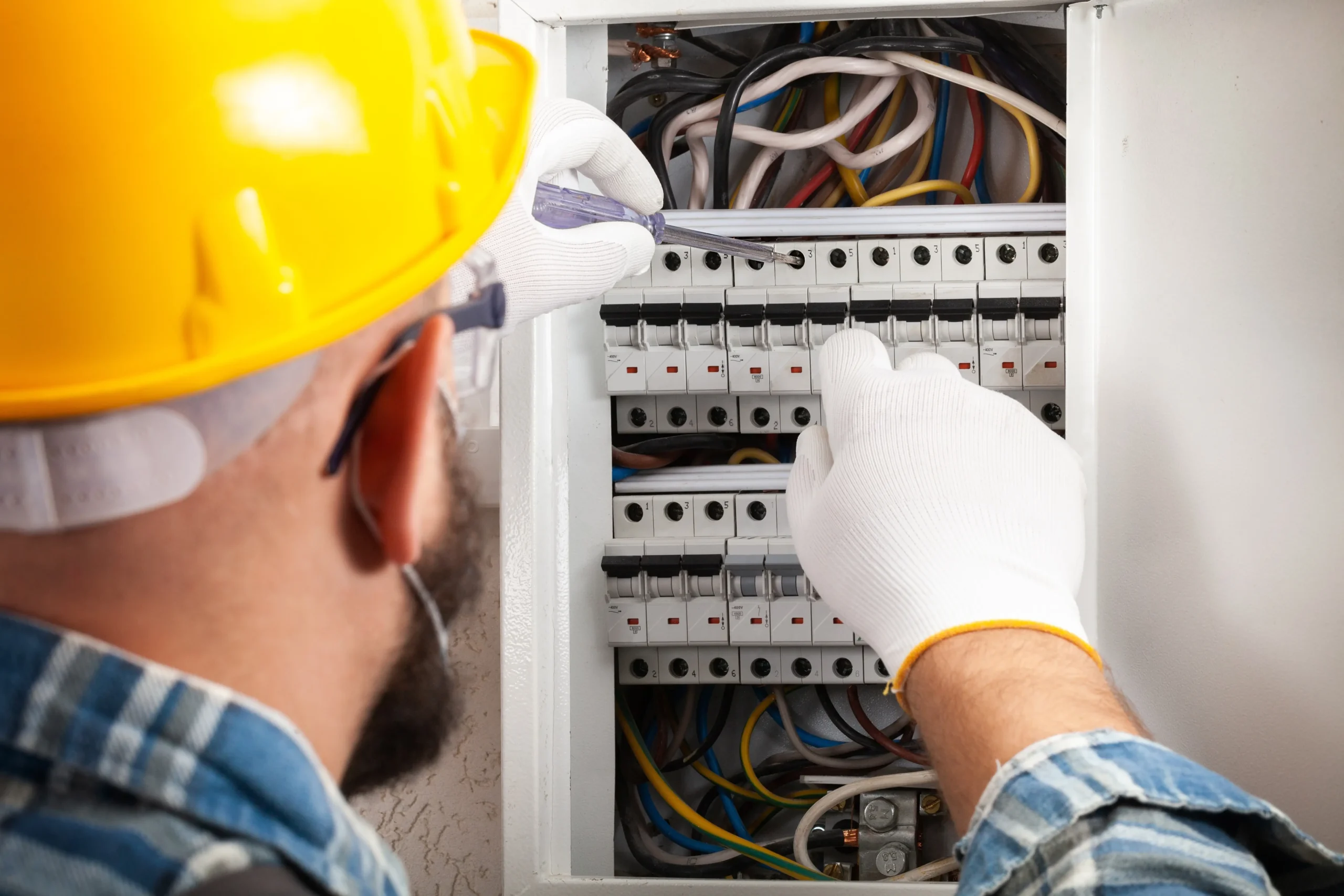
What are the technical criteria for authorizing a worker to perform electrical tasks?
Authorizing a worker to perform electrical work depends on three regulatory pillars required by NR 10: specific training, medical fitness, and formal documentation. Therefore, the company must issue a written authorization and maintain records of the technical training, including its program content, duration, and evaluation.
Mandatory technical criteria:
Completion of Basic NR 10 Training (or Supplementary SEP, if applicable);
Updated occupational health certificate;
Internal formal authorization document, signed by the employer;
Record of the worker’s qualification and the ART (Technical Responsibility Annotation) issued by a legally qualified professional.
What are the most common mistakes in the application of NR 10?
The most frequent mistake is treating NR 10 as just a course instead of a documented and continuous electrical safety management system. As a result, many companies overlook critical elements such as issuing ARTs, updating the electrical dossier (PIE), or formally releasing energized services.
Other recurring mistakes include:
Lack of periodic inspections in electrical systems;
Failure to implement lockout and proper signage during maintenance;
Use of inadequate or expired PPE;
Performing work without risk analysis or formal work release;
Failure to carry out mandatory refresher training every two years.
NR 10 Basic Course: Does NR 10 also apply to photovoltaic systems and solar panels?
Yes. NR 10 fully applies to photovoltaic systems, as they involve the generation, conversion, and distribution of electrical energy. The entire electrical infrastructure associated with solar panels—including inverters, circuit breakers, and cabling requires adherence to the control measures established by the standard.
In addition, photovoltaic installations often operate with high DC voltages, which increase complexity and risk. Compliance with NR 10 is mandatory for both residential and industrial projects. It is also recommended to complement NR 10 with ABNT NBR 16690, which specifically covers photovoltaic electrical installations.
Does NR 10 require periodic inspections of electrical installations? How often?
Yes. NR 10 mandates that all electrical installations be periodically inspected, tested, and documented. The exact frequency depends on system criticality, the operational environment, and the technical assessment outlined in the maintenance plan.
Inspection frequency guidelines:
Critical installations: every 6 to 12 months;
Aggressive or humid environments: semiannually;
Protective equipment: as per manufacturer’s recommendations or usage intensity;
Technical reports: updated after modifications or when the PIE expires (usually every 2 years).
What is the difference between the hazard zone and the controlled zone in NR 10?
According to NR 10, the hazard zone is the area where there is a real possibility of contact with energized parts, defined as voltages above 50V AC or 120V DC. The controlled zone, on the other hand, is a restricted access area surrounding the electrical installation, requiring proper authorization, signage, and PPE usage.
Technical summary:
| Zone | Technical Definition | Requirements |
|---|---|---|
| Hazard Zone | Area with the potential for electric shock | Lockout, PPE, authorized and trained personnel |
| Controlled Zone | Safety perimeter around the installation | Signage, restricted access, formal authorization |

NR 10 Basic Course: When is the Electrical Installation Dossier (PIE) legally required?
The PIE is mandatory for all companies with low or medium voltage electrical installations, as defined in item 10.2.4 of NR 10. It must be available on-site and updated whenever modifications, inspections, or renovations occur.
At a minimum, the PIE must include:
The single-line diagram of the electrical installation;
Technical reports and inspection certificates;
Specifications of protective equipment;
Operational procedures and safety instructions;
Records of worker training and formal authorizations.
Without the PIE, the company cannot demonstrate technical compliance, exposing itself to legal and operational penalties.
How do the technical documents required by NR 10 support the company’s legal defense?
The technical documentation required by NR 10 serves as formal evidence of the company’s diligence in managing electrical risks. In the event of an accident, inspection, or labor lawsuit, these documents prove that the organization has implemented the required control measures and properly trained its workers.
Documents with high legal value include:
The ART (Technical Responsibility Annotation) issued by the certified professional in charge of the electrical system;
An up-to-date PIE with inspection and maintenance records;
Attendance sheets for trainings and formal worker authorizations;
Signed operational procedures and safety instructions.
Therefore, without these records, the company not only weakens its legal position but also becomes vulnerable to liability for technical negligence.
Click the Link: Criteria for Certificate Issuance According to Standards
Certificate of Completion
Conteúdo Programático
NR 10 Basic Course
NR 10 BASIC TRAINING COURSE SAFETY IN ELECTRICITY INSTALLATIONS AND SERVICES
Total Duration: 40 Hours
Module 1: (2 hours)
Introduction to Electrical Safety
Module 2: (6 hours)
Hazards in Electrical Installations and Services
a) Electric shock – mechanisms and effects
b) Electric arcs – burns and falls
c) Electromagnetic fields
Module 3: (4 hours)
Risk Analysis Techniques
Module 4: (8 hours)
Electrical Risk Control Measures
a) De-energization
b) Functional grounding (TN/TT/IT); protective and temporary grounding
c) Equipotential bonding
d) Automatic power shutdown
e) Residual current devices (RCDs)
f) Extra-low voltage (ELV) systems
g) Barriers and enclosures
h) Lockouts and interlocks
i) Obstacles and shields
j) Live parts insulation
k) Double or reinforced insulation
l) Placing out of reach
m) Electrical separation
Module 5: (3 hours)
Brazilian Technical Standards – ABNT NBR
NBR 5410, NBR 14039 and others
Module 6: (3 hours)
Ministry of Labor and Employment Regulations (MTE)
a) Regulatory Standards (NRs)
b) NR-10 (Safety in Electrical Installations and Services)
c) Qualification, habilitation, training, and authorization
Module 7: (2 hours)
Collective Protection Equipment (CPE)
Module 8: (2 hours)
Personal Protective Equipment (PPE)
Module 9: (3 hours)
Work Routines – Procedures
a) De-energized installations
b) Work clearance procedures
c) Signage
d) Inspections of areas, tasks, tools, and equipment
Module 10: (2 hours)
Electrical Installation Documentation
Module 11: (3 hours)
Additional Risks
a) Work at heights
b) Confined spaces
c) Indoor environments
d) Humidity
e) Weather conditions
Module 12: (3 hours)
Fire Protection and Firefighting
a) Basic concepts
b) Preventive measures
c) Extinguishing methods
d) Practical training
Module 13: (2 hours)
Electric-Origin Accidents
a) Direct and indirect causes
b) Case discussions
Module 14: (4 hours)
First Aid
a) Understanding injuries
b) Response prioritization
c) Artificial respiration
d) Cardiopulmonary resuscitation (CPR)
e) Techniques for victim removal and transportation
f) Practical exercises
Module 15: (1 hour)
Responsibilities
Final Activities and Certification:
Practical exercises
Evidence recording
Theoretical assessment
Practical assessment (when contracted)
Certificate of participation
NOTE:
We emphasize that the General Normative Programmatic Content of the Course or Training may be altered, updated, adding or excluding items as needed by our Multidisciplinary Team.
Our Multidisciplinary Team may update, adjust, alter and/or exclude items, as well as insert or exclude Standards, Laws, Decrees or technical parameters they deem applicable, whether related or not, and the Contractor will be responsible for making the due attentions in what the pertinent Legislations dispose.
NR 10 Basic Course
Conteúdo Programático Normativo
NR 10 Basic Course
NR 10 BASIC TRAINING COURSE SAFETY IN ELECTRICITY INSTALLATIONS AND SERVICES
Total Duration: 40 Hours
Module 1: (2 hours)
Introduction to Electrical Safety
Module 2: (6 hours)
Hazards in Electrical Installations and Services
a) Electric shock – mechanisms and effects
b) Electric arcs – burns and falls
c) Electromagnetic fields
Module 3: (4 hours)
Risk Analysis Techniques
Module 4: (8 hours)
Electrical Risk Control Measures
a) De-energization
b) Functional grounding (TN/TT/IT); protective and temporary grounding
c) Equipotential bonding
d) Automatic power shutdown
e) Residual current devices (RCDs)
f) Extra-low voltage (ELV) systems
g) Barriers and enclosures
h) Lockouts and interlocks
i) Obstacles and shields
j) Live parts insulation
k) Double or reinforced insulation
l) Placing out of reach
m) Electrical separation
Module 5: (3 hours)
Brazilian Technical Standards – ABNT NBR
NBR 5410, NBR 14039 and others
Module 6: (3 hours)
Ministry of Labor and Employment Regulations (MTE)
a) Regulatory Standards (NRs)
b) NR-10 (Safety in Electrical Installations and Services)
c) Qualification, habilitation, training, and authorization
Module 7: (2 hours)
Collective Protection Equipment (CPE)
Module 8: (2 hours)
Personal Protective Equipment (PPE)
Module 9: (3 hours)
Work Routines – Procedures
a) De-energized installations
b) Work clearance procedures
c) Signage
d) Inspections of areas, tasks, tools, and equipment
Module 10: (2 hours)
Electrical Installation Documentation
Module 11: (3 hours)
Additional Risks
a) Work at heights
b) Confined spaces
c) Indoor environments
d) Humidity
e) Weather conditions
Module 12: (3 hours)
Fire Protection and Firefighting
a) Basic concepts
b) Preventive measures
c) Extinguishing methods
d) Practical training
Module 13: (2 hours)
Electric-Origin Accidents
a) Direct and indirect causes
b) Case discussions
Module 14: (4 hours)
First Aid
a) Understanding injuries
b) Response prioritization
c) Artificial respiration
d) Cardiopulmonary resuscitation (CPR)
e) Techniques for victim removal and transportation
f) Practical exercises
Module 15: (1 hour)
Responsibilities
Final Activities and Certification:
Practical exercises
Evidence recording
Theoretical assessment
Practical assessment (when contracted)
Certificate of participation
NOTE:
We emphasize that the General Normative Programmatic Content of the Course or Training may be altered, updated, adding or excluding items as needed by our Multidisciplinary Team.
Our Multidisciplinary Team may update, adjust, alter and/or exclude items, as well as insert or exclude Standards, Laws, Decrees or technical parameters they deem applicable, whether related or not, and the Contractor will be responsible for making the due attentions in what the pertinent Legislations dispose.
NR 10 Basic Course
Carga Horária
NR 10 Basic Course
Inexperienced Participants:
Minimum credit hours = 80 hours/class
Experienced Participants:
Minimum credit hours = 40 hours/class
Update (Recycling):
Minimum credit hours = 20 hours/class
Updating (Recycling): The employer must carry out periodic training Biennial and whenever any of the following situations occur:
a) change in work procedures, conditions or operations;
b) event that indicates the need for new training;
c) return from work leave for a period exceeding ninety days;
d) change of company;
NR 10 Basic Course
Referências Normativas
NR 10 Basic Course
Normative references when applicable to applicable devices and their updates:
NR 01 – Disposições Gerais e Gerenciamento de Riscos Ocupacionais – (General Provisions and Occupational Risk Management);
NR 06 – Equipamento de Proteção Individual – EPI – (Personal Protective Equipment – PPE);
NR 10 – Segurança em Instalações e Serviços em Eletricidade – (Electricity Facilities Safety and Services);
ABNT NBR 5410 – Instalações Elétricas de Baixa Tensão – (Low Voltage Electrical Installations);
ABNT NBR 10439 – Instalações elétricas de média tensão de 1,0 kV a 36,2 kV – (Medium voltage electrical installations from 1.0 kV to 36.2 kV)
ABNT NBR 16746 – Segurança de máquinas – Manual de Instruções – Princípios gerais de elaboração – (Machine safety – Instruction Manual – General construction principles);
ABNT NBR 13759 – Segurança de máquinas – Equipamentos de parada de emergência – Aspectos funcionais – Princípios para projeto – (Machine safety – Emergency stop equipment – Functional aspects – Project principles);
ABNT NBR ISO 14121-2 – Segurança de máquinas – Apreciação de riscos – (Machine safety – Risk assessment);
ABNT NBR 14277 – Instalações e equipamentos para treinamento de combate a incêndio – Requisitos – (Fire-fighting training facilities and equipment – Requirements);
Protocol – Guidelines American Heart Association;
ISO 10015 – Gestão da qualidade – Diretrizes para treinamento – (Quality Management – Training Guidelines);
ISO 45001 – Sistemas de gestão de saúde e segurança ocupacional – Requisitos com orientação para uso – (Occupational health and safety management systems – Requirements with guidance for use);
Note: This Service exclusively meets the requirements of the MTE (Ministry of Labor and Employment) when dealing with other bodies, inform in the act of request.
NR 10 Basic Course
Complementos
NR 10 Basic Course
Our pedagogical project follows the guidelines imposed by Regulatory Standard nº1.
After payment is made, Purchase Order, Contract signed between the parties, or other form of closing confirmation, the teaching material will be released within 72 working hours (up to 9 days), due to the adaptation of the syllabus and compliance with the Standards Techniques applicable to the scenario expressed by the Contracting Party; as well as other adaptations to the didactic material, carried out by our Multidisciplinary Team for technical language according to the student’s nationality and Technical Operational and Maintenance Instruction Manuals specific to the activities that will be carried out.
Attention: The Course teaches how to Apply the normative concepts of the standard, which enables you to sign Projects, Reports, Expertise etc. these are the attributions that the (a) Legally Qualified Professional has with their Class Council, such as CREA.
This course aims to study situations where it will be necessary to apply: Concepts and Calculations according to relevant Standards and does not replace the analysis and responsibility on the part of each professional accredited by CREA or other Class Councils in the most varied situations, where makes it imperative to respect the conservation conditions of the equipment, periodic checking of the instruments, such as respect for the primary capacity predetermined by the PPE manufacturers, among others based on the corresponding Standards.
OTHER ELEMENTS WHEN APPLICABLE AND CONTRACTED:
Normative Programmatic Content:
I – For authorized workers:
minimum workload – 40h:
Minimum Schedule:
Introduction to safety with electricity.
Risks in electrical installations and services:
a) electric shock, mechanisms and effects;
b) electric arcs; burns and falls;
c) electromagnetic fields.
Risk Analysis Techniques.
Electrical Risk Control Measures:
a) de-energizing.
b) functional grounding (TN / TT / IT); of protection; temporary;
c) equipotentialization;
d) automatic feeding sectioning;
e) leakage current devices;
f) extra-low voltage;
g) barriers and enclosures;
h) blocks and impediments;
i) obstacles and bulkheads;
j) isolation of live parts;
k) double or reinforced insulation;
l) out of reach placement;
m) electrical separation.
Brazilian Technical Standards – NBR of ABNT: NBR-5410, NBR 14039 and others;
MTE regulations:
a) NRs;
b) NR-10 (Safety in Installations and Services with Electricity);
c) qualification; training and authorization.
Collective protection equipment.
Equipments for individual safety.
Work routines – Procedures.
a) de-energized facilities;
b) release for services;
c) signaling;
d) inspections of areas, services, tools and equipment;
Documentation of electrical installations.
Additional risks:
a) height;
b) confined environments;
c) classified areas;
d) humidity;
e) atmospheric conditions.
Fire protection and fire fighting:
a) basics;
b) preventive measures;
c) extinction methods;
d) practice;
Accidents of electrical origin:
a) direct and indirect causes;
b) case discussion;
First aid:
a) notions about injuries;
b) prioritization of care;
c) application of artificial respiration;
d) cardiac massage;
e) techniques for the removal and transport of casualties;
f) practices.
Responsibilities.
Complements for Machines and Equipment when applicable:
Awareness of Importance:
Machine or Equipment Operation Instruction Manual;
Machine or Equipment Inspection and Maintenance Plan following NR 12;
Technical Report with ART of the Machine or Equipment according to NR 12;
NR 10 Electrical Tests;
Tagging of Machines and Equipment;
RETROFIT – Modernization Process;
Daily Checklist;
Punctual or cyclical maintenance.
Activity Complements:
Awareness of Importance:
APR (Preliminary Risk Analysis);
PAE (Emergency Action Plan);
PGR (Risk Management Plan);
Understanding the need for the Rescue Team;
The importance of knowledge of the task;
Accident prevention and first aid notions;
Fire protection;
Perception of risks and factors that affect people’s perceptions;
Impact and behavioral factors on safety;
Fear factor;
How to find the fastest and easiest way to develop Skills;
How to control the mind while working;
How to administer and manage working time;
Why balance energy during activity in order to obtain productivity;
Consequences of Habituation of Risk;
Work accident causes;
Notions about the Tree of Causes;
Notions about Fault Tree;
Understanding Ergonomics;
Job Analysis;
Ergonomic Hazards;
Hazard Communication Standard (HCS) – OSHA;
Practical exercises:
Registration of Evidence;
Theoretical and Practical Assessment;
Certificate of participation.
NR 10 Basic Course
Saiba Mais
Learn More: NR 10 Basic Course
Regulatory Standard NR-10 – Safety in Facilities and Electricity Services […]
Item 10.8 – HABILITATION, QUALIFICATION, TRAINING AND AUTHORIZATION OF WORKERS
10.8.1 A qualified worker is considered to be a person who can prove completion of a specific course in the electrical area recognized by the Official Education System.
10.8.2 A previously qualified worker registered with the competent class council is considered a legally qualified professional.
10.8.3 A skilled worker is considered to be one who simultaneously meets the following conditions:
a) receive training under the guidance and responsibility of a qualified and authorized professional;
b) work under the responsibility of a qualified and authorized professional.
10.8.3.1 The training will only be valid for the company that trained it and under the conditions established by the qualified and authorized professional responsible for the training.
10.8.4 Capacitated or qualified workers and capable professionals are considered authorized, with formal consent from the company.
10.8.5 The company must establish an identification system that allows at any time to know the scope of authorization of each worker, according to item 10.8.4.
10.8.6 Workers authorized to work on electrical installations must have this condition recorded in the company’s employee registration system.
10.8.7 Workers authorized to intervene in electrical installations must undergo a health examination compatible with the activities to be developed, carried out in accordance with NR 7 and registered in their medical record.
10.8.8 Workers authorized to intervene in electrical installations must have specific training on the risks arising from the use of electrical energy and the main accident prevention measures in electrical installations, in accordance with the provisions of Annex III of this NR. (Amended by MTPS Ordinance No. 509 of April 29, 2016)
10.8.8.1 The company will grant authorization in the form of this NR to trained or qualified workers and to qualified professionals who have participated with satisfactory evaluation and success in the courses listed in Annex III of this NR. (Amended by MTPS Ordinance No. 509 of April 29, 2016)
10.8.8.2 A biennial refresher training must be carried out whenever any of the following situations occur:
a) change of function or change of company;
b) return from work leave or inactivity for a period exceeding three months;
c) significant changes in electrical installations or change of methods, processes and organization of work.
10.8.8.3 The workload and program content of the refresher training aimed at meeting items “a”, “b” and “c” from item 10.8.8.2 must meet the needs of the situation that motivated it.
10.8.8.4 Work in classified areas must be preceded by specific training according to the risk involved.
10.8.9 Workers with activities not related to electrical installations developed in a free zone and in the vicinity of the controlled zone, as defined in this NR, must be formally instructed with knowledge that allows them to identify and assess their possible risks and adopt the appropriate precautions.
F: NR 10.
01 – URL FOTO: Licensor’s author: family31 – Freepik.com
02 – URL FOTO: Licensor’s author: BillionPhotos – Freepik.com
03 – URL FOTO: Licensor’s author: pvproductions – Freepik.com
Curso NR 10 Básico em Inglês: Consult us.
Escopo do Serviço
Substituir:
Fonte:
Avaliação qualitativa;
Avaliação quantitativa;
Tagueamento de Máquinas e Equipamentos;
RETROFIT – Processo de Modernização;
Manutenções pontuais ou cíclicas.
Verificações quando for pertinentes:
Manual de Instrução de Operação da Máquina ou Equipamento;
Plano de Inspeção e Manutenção da Máquina ou Equipamento seguindo a NR 12;
Relatório Técnico com ART da Máquina ou Equipamento conforme NR 12;
Teste de Carga (com ART) conforme NR 12;
END (Ensaios Não Destrutivos) conforme NR 12;
APR (Análise Preliminar de Risco);
Disposições Finais:
Caderno, Registro fotográfico e Registros de Avaliação;
Registro das Evidências;
Identificação dos Profissionais (Engenheiros e Peritos);
Conclusão do PLH;
Proposta de melhorias corretivas;
Quando Aplicável: Certificado de Calibração;
Emissão da A.R.T. (Anotação de Responsabilidade Técnica) e/ou C.R.T. (Certificação de Responsabilidade Técnica).
Procedimentos e Aparelhos utilizados:
É facultado à nossa Equipe Multidisciplinar a inserção de normas, leis, decretos ou parâmetros técnicos que julgarem aplicáveis, sendo relacionados ou não ao escopo de serviço negociado, ficando a Contratante responsável por efetuar os devidos atendimentos no que dispõem as legislações, conforme estabelecido nas mesmas.
Validade
Substituir:
Validade das Inspeções: ANUAL exceto se ocorrer quaisquer das seguintes situações:
a) mudança nos procedimentos, finalidades, condições ou operações de trabalho;
b) evento que indique a necessidade de nova Inspeção;
c) mudança de empresa;
d) troca de máquina ou equipamento.
Será emitido Documento Técnico por Profissionais Legalmente Habilitados Perito e Engenheiro de Segurança do Trabalho com ART;
Os Equipamentos utilizados possuem Atestado de Aferição vigente e demais equipamentos são analógicos.
Complementos
Cabe a Contratante fornecer quando for o caso:
Fornecer os meios, Projetos arquitetônicos em AutoCad ou PDF;
Projeto Arquitetônico da Empresa que efetuará ou efetuou a instalação e contato com os mesmos.
Lista de todos os equipamentos elétricos e eletrônicos contidos nas áreas com marca, potência modelo, tipo e temperatura;
Se tiver inflamáveis e/ou combustíveis armazenados com mais 200 litros no total torna-se obrigatório fazer o Prontuário da NR-20.
Demais documentos e procedimentos necessários previstos antes ou depois da Inspeção técnica.
NÃO estão inclusos no Escopo do Serviço:
1. Elaboração de Projeto de Arquitetônico;*
2. Elaboração de Projeto de Instalação;*
3. Elaboração do Memorial de Cálculo*
4. Elaboração de Memorial de Cálculo de Suporte;*
5. Elaboração de Manual de Instrução Técnica Operacional e de Manutenção;*
* (Consultar valor)
Saiba Mais
Saiba Mais: Substituir:
*OBS: É necessário que o Plano de Inspeção Manutenção NR 12 de cada Máquina e/ou Equipamento esteja atualizado em Conformidade com as Normas Regulamentadoras.
Substituir: Consulte-nos.
Escopo Normativo do Serviço
Substituir:
Fonte:
Avaliação qualitativa;
Avaliação quantitativa;
Tagueamento de Máquinas e Equipamentos;
RETROFIT – Processo de Modernização;
Manutenções pontuais ou cíclicas.
Verificações quando for pertinentes:
Manual de Instrução de Operação da Máquina ou Equipamento;
Plano de Inspeção e Manutenção da Máquina ou Equipamento seguindo a NR 12;
Relatório Técnico com ART da Máquina ou Equipamento conforme NR 12;
Teste de Carga (com ART) conforme NR 12;
END (Ensaios Não Destrutivos) conforme NR 12;
APR (Análise Preliminar de Risco);
Disposições Finais:
Caderno, Registro fotográfico e Registros de Avaliação;
Registro das Evidências;
Identificação dos Profissionais (Engenheiros e Peritos);
Conclusão do PLH;
Proposta de melhorias corretivas;
Quando Aplicável: Certificado de Calibração;
Emissão da A.R.T. (Anotação de Responsabilidade Técnica) e/ou C.R.T. (Certificação de Responsabilidade Técnica).
Procedimentos e Aparelhos utilizados:
É facultado à nossa Equipe Multidisciplinar a inserção de normas, leis, decretos ou parâmetros técnicos que julgarem aplicáveis, sendo relacionados ou não ao escopo de serviço negociado, ficando a Contratante responsável por efetuar os devidos atendimentos no que dispõem as legislações, conforme estabelecido nas mesmas.
Referências Normativas
Referências Normativas (Fontes) aos dispositivos aplicáveis, suas atualizações e substituições até a presente data:
NR 07 – Programa de Controle Médico de Saúde Ocupacional – PCMSO;
NR 09 – Avaliação e Controle das Exposições Ocupacionais a Agentes Físicos, Químicos e Biológicos;
ABNT NBR 5426 – Planos de amostragem e procedimentos na inspeção por atributos;
ABNT NBR 10719 – Informação e documentação – Relatório técnico e/ou científico – Apresentação;
ABNT NBR 16746 – Segurança de máquinas – Manual de Instruções – Princípios gerais de elaboração;
NBR ISO 13850 – Segurança de Máquinas – Função de parada de emergência – Princípios para projeto;
ABNT ISO/TR 14121-2 – Segurança de máquinas – Apreciação de riscos;
ABNT NBR 14277 – Instalações e equipamentos para treinamento de combate a incêndio – Requisitos;
NBRISO/IEC27557 – Segurança da Informação, segurança cibernética e proteção da privacidade;
ABNT NBR ISO/IEC 17011 – Avaliação da Conformidade – Requisitos para os Organismos de Acreditação que Acreditam Organismos de Avaliação da Conformidade;
ABNT NBR ISO/IEC 17025 – Requisitos Gerais para a Competência de Laboratórios de Ensaios e Calibração;
ABNT NBR ISO 31000 – Gestão de riscos de privacidade organizacional;
ISO 45001 – Sistemas de gestão de saúde e segurança ocupacional – Requisitos com orientação para uso;
Target Normas;
Associação Brasileira de Normas Técnicas – ABNT;
Outras Normas Técnicas Aplicáveis.
Nota: Este Serviço atende exclusivamente as exigências da MTE (Ministério do Trabalho e Emprego) quando se tratar de atendimento a outros Órgãos, informe no ato da solicitação.
Validade
Substituir:
Validade das Inspeções: ANUAL exceto se ocorrer quaisquer das seguintes situações:
a) mudança nos procedimentos, finalidades, condições ou operações de trabalho;
b) evento que indique a necessidade de nova Inspeção;
c) mudança de empresa;
d) troca de máquina ou equipamento.
Será emitido Documento Técnico por Profissionais Legalmente Habilitados Perito e Engenheiro de Segurança do Trabalho com ART;
Os Equipamentos utilizados possuem Atestado de Aferição vigente e demais equipamentos são analógicos.
Complementos
A relação de EPIs necessários
Prontuários de cada máquina e seus últimos Relatórios Técnicos, Projetos caso hajam;
Cabe a Contratante fornecer quando for o caso:
Fornecer os meios, Projetos arquitetônicos em Arquivo DWG ou PDF;
Projeto Arquitetônico da Empresa que efetuará ou efetuou a instalação e contato com os mesmos.
Lista de todos os equipamentos elétricos e eletrônicos contidos nas áreas com marca, potência modelo, tipo e temperatura;
Se tiver inflamáveis e/ou combustíveis armazenados com mais 200 litros no total torna-se obrigatório fazer o Prontuário da NR-20.
Demais documentos e procedimentos necessários previstos antes ou depois da Inspeção técnica.
NÃO estão inclusos no Escopo do Serviço:
1. Elaboração de Projeto de Arquitetônico;*
2. Elaboração de Projeto de Instalação;*
3. Elaboração do Memorial de Cálculo*
4. Elaboração de Memorial de Cálculo de Suporte;*
5. Elaboração de Manual de Instrução Técnica Operacional e de Manutenção;*
* (Consultar valor)
O que são Células de Carga?
As células de carga são medidores de deformação ou flexão de um corpo, transformando grandeza física, ou seja, uma força, em um sinal elétrico. Utilizadas na análise experimental de esforços e na medição elétrica da resistência à tensão, essas células são empregadas na maioria das aplicações industriais.
Documentos necessários para Equipamentos de Içamento
a) Arts do Pórtico com os últimos 3 laudos, incluindo a ART com Memorial de Cálculo do Projeto Inicial do Pórtico;
b) Memoriais de Cálculo de Dimensionamento da Talha atual X pórtico com ART;
c) Memoriais de cálculo de carga do moitão da talha e dos cabos de aço com ART;
d) ART da Montagem da Talha com Memorial de Cálculo Estrutural;
e) Todas as soldas constantes no pórtico deverão estar sem tintas ou resíduos e também não deverão estar lixadas, bem como o moitão e o gancho da talha;
f) O setor deve ficar interditado até segunda ordem para os testes;
g) Deverá ter uma carga disponível com uma balança calibrada e com Laudo da capacidade e uma carga com 175%.
h) O Eng de segurança do trabalho em conjunto com o SESMT deverão emitir uma declaração de responsabilidade quanto ao teste de carga em caso de rompimento ou acidente com um de nossos colaboradores;
i) Todos os Sistemas Elétricos deverão estar desativados com sistema Power Lockout;
Serão utilizados os sistemas de líquido penetrante e líquido revelador nas soldas o que poderá intoxicar quaisquer alimentos presentes.
j) O Teste de Carga será realizado conforme norma da ABNT desde que autorizado e declarado pelos responsáveis a inteira responsabilidade por quaisquer questões que ocorram com nossos colaboradores durante o teste. Sendo este executado em 1 hora com carga a 100% da carga talha e mais uma hora com 125% da carga talha.
l) Observe-se que, se não houverem as documentações solicitadas, que a empresa declare que não há via e-mail.
Plano de Inspeção e Manutenção do Equipamento é obrigatório conforme previsto na NR 12.
Saiba Mais
Learn More: NR 10 Basic Course
Regulatory Standard NR-10 – Safety in Facilities and Electricity Services […]
Item 10.8 – HABILITATION, QUALIFICATION, TRAINING AND AUTHORIZATION OF WORKERS
10.8.1 A qualified worker is considered to be a person who can prove completion of a specific course in the electrical area recognized by the Official Education System.
10.8.2 A previously qualified worker registered with the competent class council is considered a legally qualified professional.
10.8.3 A skilled worker is considered to be one who simultaneously meets the following conditions:
a) receive training under the guidance and responsibility of a qualified and authorized professional;
b) work under the responsibility of a qualified and authorized professional.
10.8.3.1 The training will only be valid for the company that trained it and under the conditions established by the qualified and authorized professional responsible for the training.
10.8.4 Capacitated or qualified workers and capable professionals are considered authorized, with formal consent from the company.
10.8.5 The company must establish an identification system that allows at any time to know the scope of authorization of each worker, according to item 10.8.4.
10.8.6 Workers authorized to work on electrical installations must have this condition recorded in the company’s employee registration system.
10.8.7 Workers authorized to intervene in electrical installations must undergo a health examination compatible with the activities to be developed, carried out in accordance with NR 7 and registered in their medical record.
10.8.8 Workers authorized to intervene in electrical installations must have specific training on the risks arising from the use of electrical energy and the main accident prevention measures in electrical installations, in accordance with the provisions of Annex III of this NR. (Amended by MTPS Ordinance No. 509 of April 29, 2016)
10.8.8.1 The company will grant authorization in the form of this NR to trained or qualified workers and to qualified professionals who have participated with satisfactory evaluation and success in the courses listed in Annex III of this NR. (Amended by MTPS Ordinance No. 509 of April 29, 2016)
10.8.8.2 A biennial refresher training must be carried out whenever any of the following situations occur:
a) change of function or change of company;
b) return from work leave or inactivity for a period exceeding three months;
c) significant changes in electrical installations or change of methods, processes and organization of work.
10.8.8.3 The workload and program content of the refresher training aimed at meeting items “a”, “b” and “c” from item 10.8.8.2 must meet the needs of the situation that motivated it.
10.8.8.4 Work in classified areas must be preceded by specific training according to the risk involved.
10.8.9 Workers with activities not related to electrical installations developed in a free zone and in the vicinity of the controlled zone, as defined in this NR, must be formally instructed with knowledge that allows them to identify and assess their possible risks and adopt the appropriate precautions.
F: NR 10.
01 – URL FOTO: Licensor’s author: family31 – Freepik.com
02 – URL FOTO: Licensor’s author: BillionPhotos – Freepik.com
03 – URL FOTO: Licensor’s author: pvproductions – Freepik.com
Curso NR 10 Básico em Inglês: Consult us.
Escopo do Serviço
Substituir:
Fonte:
Avaliação qualitativa;
Avaliação quantitativa;
Tagueamento de Máquinas e Equipamentos;
RETROFIT – Processo de Modernização;
Manutenções pontuais ou cíclicas.
Verificações quando for pertinentes:
Manual de Instrução de Operação da Máquina ou Equipamento;
Plano de Inspeção e Manutenção da Máquina ou Equipamento seguindo a NR 12;
Relatório Técnico com ART da Máquina ou Equipamento conforme NR 12;
Teste de Carga (com ART) conforme NR 12;
END (Ensaios Não Destrutivos) conforme NR 12;
APR (Análise Preliminar de Risco);
Disposições Finais:
Caderno, Registro fotográfico e Registros de Avaliação;
Registro das Evidências;
Identificação dos Profissionais (Engenheiros e Peritos);
Conclusão do PLH;
Proposta de melhorias corretivas;
Quando Aplicável: Certificado de Calibração;
Emissão da A.R.T. (Anotação de Responsabilidade Técnica) e/ou C.R.T. (Certificação de Responsabilidade Técnica).
Procedimentos e Aparelhos utilizados:
É facultado à nossa Equipe Multidisciplinar a inserção de normas, leis, decretos ou parâmetros técnicos que julgarem aplicáveis, sendo relacionados ou não ao escopo de serviço negociado, ficando a Contratante responsável por efetuar os devidos atendimentos no que dispõem as legislações, conforme estabelecido nas mesmas.
Validade
Substituir:
Validade das Inspeções: ANUAL exceto se ocorrer quaisquer das seguintes situações:
a) mudança nos procedimentos, finalidades, condições ou operações de trabalho;
b) evento que indique a necessidade de nova Inspeção;
c) mudança de empresa;
d) troca de máquina ou equipamento.
Será emitido Documento Técnico por Profissionais Legalmente Habilitados Perito e Engenheiro de Segurança do Trabalho com ART;
Os Equipamentos utilizados possuem Atestado de Aferição vigente e demais equipamentos são analógicos.
Complementos
Cabe a Contratante fornecer quando for o caso:
Fornecer os meios, Projetos arquitetônicos em AutoCad ou PDF;
Projeto Arquitetônico da Empresa que efetuará ou efetuou a instalação e contato com os mesmos.
Lista de todos os equipamentos elétricos e eletrônicos contidos nas áreas com marca, potência modelo, tipo e temperatura;
Se tiver inflamáveis e/ou combustíveis armazenados com mais 200 litros no total torna-se obrigatório fazer o Prontuário da NR-20.
Demais documentos e procedimentos necessários previstos antes ou depois da Inspeção técnica.
NÃO estão inclusos no Escopo do Serviço:
1. Elaboração de Projeto de Arquitetônico;*
2. Elaboração de Projeto de Instalação;*
3. Elaboração do Memorial de Cálculo*
4. Elaboração de Memorial de Cálculo de Suporte;*
5. Elaboração de Manual de Instrução Técnica Operacional e de Manutenção;*
* (Consultar valor)
Saiba Mais
Saiba Mais: Substituir:
*OBS: É necessário que o Plano de Inspeção Manutenção NR 12 de cada Máquina e/ou Equipamento esteja atualizado em Conformidade com as Normas Regulamentadoras.
Substituir: Consulte-nos.
Escopo do Serviço
Substituir:
Fonte:
Avaliação qualitativa;
Avaliação quantitativa;
Tagueamento de Máquinas e Equipamentos;
RETROFIT – Processo de Modernização;
Manutenções pontuais ou cíclicas.
Verificações quando for pertinentes:
Manual de Instrução de Operação da Máquina ou Equipamento;
Plano de Inspeção e Manutenção da Máquina ou Equipamento seguindo a NR 12;
Relatório Técnico com ART da Máquina ou Equipamento conforme NR 12;
Teste de Carga (com ART) conforme NR 12;
END (Ensaios Não Destrutivos) conforme NR 12;
APR (Análise Preliminar de Risco);
Disposições Finais:
Registro fotográfico;
Registro das Evidências;
Conclusão do PLH;
Proposta de melhorias corretivas;
Emissão da ART (Anotação de Responsabilidade Técnica) – exceto Laudo Pericial;
Cabe a Contratante fornecer quando for o caso:
Fornecer os meios, Projetos arquitetônicos em AutoCad ou PDF;
Projeto Arquitetônico da Empresa que efetuará ou efetuou a instalação e contato com os mesmos.
Lista de todos os equipamentos elétricos e eletrônicos contidos nas áreas com marca, potência modelo, tipo e temperatura;
Se tiver inflamáveis e/ou combustíveis armazenados com mais 200 litros no total torna-se obrigatório fazer o Prontuário da NR-20.
Demais documentos e procedimentos necessários previstos antes ou depois da Inspeção técnica.
NÃO estão inclusos no Escopo do Serviço:
1. Elaboração de Projeto de Arquitetônico;*
2. Elaboração de Projeto de Instalação;*
3. Elaboração do Memorial de Cálculo*
4. Elaboração de Memorial de Cálculo de Suporte;*
5. Elaboração de Manual de Instrução Técnica Operacional e de Manutenção;*
* (Consultar valor)
O que são Células de Carga?
As células de carga são medidores de deformação ou flexão de um corpo, transformando grandeza física, ou seja, uma força, em um sinal elétrico. Utilizadas na análise experimental de esforços e na medição elétrica da resistência à tensão, essas células são empregadas na maioria das aplicações industriais.
Cabe a Contratante fornecer :
Procedimentos da Inspeção quando for o caso e se envolver Estruturas:
Importante: Serão realizados Teste de Solda e Sistema de Líquido Penetrante no equipamento e nas peças que contenham pontos de solda;
01- Os pontos que contém solda no decorrer da peça (Inclusive quando tiver braço articulado e apoio de cesto acoplado) deverão estar devidamente decapados, sem nenhum tipo de resíduos tais como tintas, vernizes, colas ou qualquer tipo de sujidades ou resíduos de óleo, graxa etc;
02- Passar PINTOFF em todas as bases do Equipamento e peças de apoio, limpar bem e passar pano (não deixar nenhuma sujidade);
03- Se tiver Lanças automáticas ou lança manual, lixar solda da frente;
04- Se Contratado Execução de TESTE DE CARGA e o equipamento não tiver Célula de Carga* cabe a Contratante disponibilizar compartimento para teste de carga (tipo big bag, cintas novas calibradas INMETRO, balança, tarugos de metal calibrado ou sacos de areia pesados equivalente até 125% que o equipamento suporta e fornecer Declaração de Responsabilidade referente a Capacidade do Equipamento.
Se Contratado ENSAIOS ELÉTRICOS em Cesto acoplado de preferência com Placa de Identificação, o mesmo deverá estar no nível do solo juntamente com Laudo de Fabricação de aparelhos que tiver para sabermos quantos Volts suporta.
Plano de Inspeção e Manutenção do Equipamento é obrigatório conforme previsto na NR 12.
Entenda a relação entre Preço e Valor:
Executar uma tarefa tão estratégica como precificar um Serviço exige conhecimento sobre o mundo dos negócios.
Dois conceitos fundamentais para entender como precificar são as definições de Preço e Valor.
Valor é um conceito qualitativo, e está ligado ao potencial transformador daquele conteúdo.
Um curso tem mais valor quando ele agrega mais conhecimentos ao público-alvo.
Preço é uma consequência do valor.
Por ser um conceito essencialmente quantitativo, ele é responsável por “traduzir” o valor em um número.
Portanto, quanto maior é o valor agregado ao conteúdo, maior será o preço justo.
Validade
Substituir:
Validade das Inspeções: ANUAL exceto se ocorrer quaisquer das seguintes situações:
a) mudança nos procedimentos, finalidades, condições ou operações de trabalho;
b) evento que indique a necessidade de nova Inspeção;
c) mudança de empresa;
d) troca de máquina ou equipamento.
Será emitido Documento Técnico por Profissionais Legalmente Habilitados Perito e Engenheiro de Segurança do Trabalho com ART;
Os Equipamentos utilizados possuem Atestado de Aferição vigente e demais equipamentos são analógicos.
Complementos
A relação de EPIs necessários
Prontuários de cada máquina e seus últimos Relatórios Técnicos, Projetos caso hajam;
Cabe a Contratante fornecer quando for o caso:
Fornecer os meios, Projetos arquitetônicos em Arquivo DWG ou PDF;
Projeto Arquitetônico da Empresa que efetuará ou efetuou a instalação e contato com os mesmos.
Lista de todos os equipamentos elétricos e eletrônicos contidos nas áreas com marca, potência modelo, tipo e temperatura;
Se tiver inflamáveis e/ou combustíveis armazenados com mais 200 litros no total torna-se obrigatório fazer o Prontuário da NR-20.
Demais documentos e procedimentos necessários previstos antes ou depois da Inspeção técnica.
NÃO estão inclusos no Escopo do Serviço:
1. Elaboração de Projeto de Arquitetônico;*
2. Elaboração de Projeto de Instalação;*
3. Elaboração do Memorial de Cálculo*
4. Elaboração de Memorial de Cálculo de Suporte;*
5. Elaboração de Manual de Instrução Técnica Operacional e de Manutenção;*
* (Consultar valor)
O que são Células de Carga?
As células de carga são medidores de deformação ou flexão de um corpo, transformando grandeza física, ou seja, uma força, em um sinal elétrico. Utilizadas na análise experimental de esforços e na medição elétrica da resistência à tensão, essas células são empregadas na maioria das aplicações industriais.
Documentos necessários para Equipamentos de Içamento
a) Arts do Pórtico com os últimos 3 laudos, incluindo a ART com Memorial de Cálculo do Projeto Inicial do Pórtico;
b) Memoriais de Cálculo de Dimensionamento da Talha atual X pórtico com ART;
c) Memoriais de cálculo de carga do moitão da talha e dos cabos de aço com ART;
d) ART da Montagem da Talha com Memorial de Cálculo Estrutural;
e) Todas as soldas constantes no pórtico deverão estar sem tintas ou resíduos e também não deverão estar lixadas, bem como o moitão e o gancho da talha;
f) O setor deve ficar interditado até segunda ordem para os testes;
g) Deverá ter uma carga disponível com uma balança calibrada e com Laudo da capacidade e uma carga com 175%.
h) O Eng de segurança do trabalho em conjunto com o SESMT deverão emitir uma declaração de responsabilidade quanto ao teste de carga em caso de rompimento ou acidente com um de nossos colaboradores;
i) Todos os Sistemas Elétricos deverão estar desativados com sistema Power Lockout;
Serão utilizados os sistemas de líquido penetrante e líquido revelador nas soldas o que poderá intoxicar quaisquer alimentos presentes.
j) O Teste de Carga será realizado conforme norma da ABNT desde que autorizado e declarado pelos responsáveis a inteira responsabilidade por quaisquer questões que ocorram com nossos colaboradores durante o teste. Sendo este executado em 1 hora com carga a 100% da carga talha e mais uma hora com 125% da carga talha.
l) Observe-se que, se não houverem as documentações solicitadas, que a empresa declare que não há via e-mail.
Plano de Inspeção e Manutenção do Equipamento é obrigatório conforme previsto na NR 12.
Saiba Mais
Learn More: NR 10 Basic Course
Regulatory Standard NR-10 – Safety in Facilities and Electricity Services […]
Item 10.8 – HABILITATION, QUALIFICATION, TRAINING AND AUTHORIZATION OF WORKERS
10.8.1 A qualified worker is considered to be a person who can prove completion of a specific course in the electrical area recognized by the Official Education System.
10.8.2 A previously qualified worker registered with the competent class council is considered a legally qualified professional.
10.8.3 A skilled worker is considered to be one who simultaneously meets the following conditions:
a) receive training under the guidance and responsibility of a qualified and authorized professional;
b) work under the responsibility of a qualified and authorized professional.
10.8.3.1 The training will only be valid for the company that trained it and under the conditions established by the qualified and authorized professional responsible for the training.
10.8.4 Capacitated or qualified workers and capable professionals are considered authorized, with formal consent from the company.
10.8.5 The company must establish an identification system that allows at any time to know the scope of authorization of each worker, according to item 10.8.4.
10.8.6 Workers authorized to work on electrical installations must have this condition recorded in the company’s employee registration system.
10.8.7 Workers authorized to intervene in electrical installations must undergo a health examination compatible with the activities to be developed, carried out in accordance with NR 7 and registered in their medical record.
10.8.8 Workers authorized to intervene in electrical installations must have specific training on the risks arising from the use of electrical energy and the main accident prevention measures in electrical installations, in accordance with the provisions of Annex III of this NR. (Amended by MTPS Ordinance No. 509 of April 29, 2016)
10.8.8.1 The company will grant authorization in the form of this NR to trained or qualified workers and to qualified professionals who have participated with satisfactory evaluation and success in the courses listed in Annex III of this NR. (Amended by MTPS Ordinance No. 509 of April 29, 2016)
10.8.8.2 A biennial refresher training must be carried out whenever any of the following situations occur:
a) change of function or change of company;
b) return from work leave or inactivity for a period exceeding three months;
c) significant changes in electrical installations or change of methods, processes and organization of work.
10.8.8.3 The workload and program content of the refresher training aimed at meeting items “a”, “b” and “c” from item 10.8.8.2 must meet the needs of the situation that motivated it.
10.8.8.4 Work in classified areas must be preceded by specific training according to the risk involved.
10.8.9 Workers with activities not related to electrical installations developed in a free zone and in the vicinity of the controlled zone, as defined in this NR, must be formally instructed with knowledge that allows them to identify and assess their possible risks and adopt the appropriate precautions.
F: NR 10.
01 – URL FOTO: Licensor’s author: family31 – Freepik.com
02 – URL FOTO: Licensor’s author: BillionPhotos – Freepik.com
03 – URL FOTO: Licensor’s author: pvproductions – Freepik.com
Curso NR 10 Básico em Inglês: Consult us.
Escopo do Serviço
Substituir:
Escopo Normativo do Serviço:
Inspeções e verificações quando pertinentes a ser avaliadas na Inspeção pela nossa Equipe multidisciplinar:
Testes e ensaios quando contratado e pertinentes:
Outros elementos quando contratado e pertinentes:
Avaliação qualitativa;
Avaliação quantitativa;
Tagueamento de Máquinas e Equipamentos;
RETROFIT – Processo de Modernização;
Manutenções pontuais ou cíclicas;
Verificações quando for pertinentes:
Manual de Instrução de Operação da Máquina ou Equipamento;
Plano de Inspeção e Manutenção da Máquina ou Equipamento seguindo a NR 12;
Relatório Técnico com ART da Máquina ou Equipamento conforme NR 12;
Teste de Carga (com ART) conforme NR 12;
END (Ensaios Não Destrutivos) conforme NR 12;
APR (Análise Preliminar de Risco);
Disposições Finais (quando pertinentes):
Caderno, Registro fotográfico e Registros de Avaliação;
Registro das Evidências;
Identificação dos Profissionais (Engenheiros e Peritos);
Conclusão do PLH;
Proposta de melhorias corretivas;
Quando Aplicável: Certificado de Calibração;
Emissão de ART (Anotação de Responsabilidade Técnica) do CREA SP,
TRT (Termo de Responsabilidade Técnica) do CFT, e
CRT (Certificado de Responsabilidade Técnica) do CNDP BRASIL.
NOTA:
É facultado à nossa Equipe Multidisciplinar Atualizar, adequar, alterar e/ou excluir itens, conforme inspeção e sempre que for necessário, bem como efetuar a exclusão ou inserção de Normas, Leis, Decretos ou parâmetros técnicos que julgarem aplicáveis, estando relacionados ou não no Escopo Normativo ficando a Contratante responsável por efetuar os devidos atendimentos no que dispõem as Legislações pertinentes.
Referências Normativas
Referências Normativas (Fontes) aos dispositivos aplicáveis, suas atualizações e substituições até a presente data:
NR 07 – Programa de Controle Médico de Saúde Ocupacional – PCMSO;
NR 09 – Avaliação e Controle das Exposições Ocupacionais a Agentes Físicos, Químicos e Biológicos;
ABNT NBR 5426 – Planos de amostragem e procedimentos na inspeção por atributos;
ABNT NBR 10719 – Informação e documentação – Relatório técnico e/ou científico – Apresentação;
ABNT NBR 16746 – Segurança de máquinas – Manual de Instruções – Princípios gerais de elaboração;
NBR ISO 13850 – Segurança de Máquinas – Função de parada de emergência – Princípios para projeto;
ABNT ISO/TR 14121-2 – Segurança de máquinas – Apreciação de riscos;
ABNT NBR 14277 – Instalações e equipamentos para treinamento de combate a incêndio – Requisitos;
NBRISO/IEC27557 – Segurança da Informação, segurança cibernética e proteção da privacidade;
ABNT NBR ISO/IEC 17011 – Avaliação da Conformidade – Requisitos para os Organismos de Acreditação que Acreditam Organismos de Avaliação da Conformidade;
ABNT NBR ISO/IEC 17025 – Requisitos Gerais para a Competência de Laboratórios de Ensaios e Calibração;
ABNT NBR ISO 31000 – Gestão de riscos de privacidade organizacional;
ISO 45001 – Sistemas de gestão de saúde e segurança ocupacional – Requisitos com orientação para uso;
Target Normas;
Associação Brasileira de Normas Técnicas – ABNT;
Outras Normas Técnicas Aplicáveis.
Nota: Este Serviço atende exclusivamente as exigências da MTE (Ministério do Trabalho e Emprego) quando se tratar de atendimento a outros Órgãos, informe no ato da solicitação.
Validade
Substituir:
Validade das Inspeções: ANUAL exceto se ocorrer quaisquer das seguintes situações:
a) mudança nos procedimentos, finalidades, condições ou operações de trabalho;
b) evento que indique a necessidade de nova Inspeção;
c) mudança de empresa;
d) troca de máquina ou equipamento.
Será emitido Documento Técnico por Profissionais Legalmente Habilitados Perito e Engenheiro de Segurança do Trabalho com ART;
Os Equipamentos utilizados possuem Atestado de Aferição vigente e demais equipamentos são analógicos.
Complementos
A relação de EPIs necessários
Prontuários de cada máquina e seus últimos Relatórios Técnicos, Projetos caso hajam;
Cabe a Contratante fornecer quando for o caso:
Fornecer os meios, Projetos arquitetônicos em Arquivo DWG ou PDF;
Projeto Arquitetônico da Empresa que efetuará ou efetuou a instalação e contato com os mesmos.
Lista de todos os equipamentos elétricos e eletrônicos contidos nas áreas com marca, potência modelo, tipo e temperatura;
Se tiver inflamáveis e/ou combustíveis armazenados com mais 200 litros no total torna-se obrigatório fazer o Prontuário da NR-20.
Demais documentos e procedimentos necessários previstos antes ou depois da Inspeção técnica.
NÃO estão inclusos no Escopo do Serviço:
1. Elaboração de Projeto de Arquitetônico;*
2. Elaboração de Projeto de Instalação;*
3. Elaboração do Memorial de Cálculo*
4. Elaboração de Memorial de Cálculo de Suporte;*
5. Elaboração de Manual de Instrução Técnica Operacional e de Manutenção;*
* (Consultar valor)
O que são Células de Carga?
As células de carga são medidores de deformação ou flexão de um corpo, transformando grandeza física, ou seja, uma força, em um sinal elétrico. Utilizadas na análise experimental de esforços e na medição elétrica da resistência à tensão, essas células são empregadas na maioria das aplicações industriais.
Cabe a Contratante fornecer :
Procedimentos da Inspeção quando for o caso e se envolver Estruturas:
Importante: Serão realizados Teste de Solda e Sistema de Líquido Penetrante no equipamento e nas peças que contenham pontos de solda;
01- Os pontos que contém solda no decorrer da peça (Inclusive quando tiver braço articulado e apoio de cesto acoplado) deverão estar devidamente decapados, sem nenhum tipo de resíduos tais como tintas, vernizes, colas ou qualquer tipo de sujidades ou resíduos de óleo, graxa etc;
02- Passar STRIPTIZI GEL em todas as bases do Equipamento e peças de apoio, limpar bem e passar pano (não deixar nenhuma sujidade);
03- Se tiver Lanças automáticas ou lança manual, lixar solda da frente;
04- Se Contratado Execução de TESTE DE CARGA cabe a Contratante disponibilizar CÉLULAS DE CARGA ou compartimento para teste de carga (tipo big bag, cintas novas calibradas INMETRO, balança, tarugos de metal calibrado ou sacos de areia pesados equivalente até 125% que o equipamento suporta e fornecer Declaração de Responsabilidade referente a Capacidade do Equipamento.
Se Contratado ENSAIOS ELÉTRICOS em Cesto acoplado de preferência com Placa de Identificação, o mesmo deverá estar no nível do solo juntamente com Laudo de Fabricação de aparelhos que tiver para sabermos quantos Volts suporta.
Documentos necessários para Equipamentos de Içamento
a) Arts do Pórtico com os últimos 3 laudos, incluindo a ART com Memorial de Cálculo do Projeto Inicial do Pórtico;
b) Memoriais de Cálculo de Dimensionamento da Talha atual X pórtico com ART;
c) Memoriais de cálculo de carga do moitão da talha e dos cabos de aço com ART;
d) ART da Montagem da Talha com Memorial de Cálculo Estrutural;
e) Todas as soldas constantes no pórtico deverão estar sem tintas ou resíduos e também não deverão estar lixadas, bem como o moitão e o gancho da talha;
f) O setor deve ficar interditado até segunda ordem para os testes;
g) Deverá ter uma carga disponível com uma balança calibrada e com Laudo da capacidade e uma carga com 175%.
h) O Eng de segurança do trabalho em conjunto com o SESMT deverão emitir uma declaração de responsabilidade quanto ao teste de carga em caso de rompimento ou acidente com um de nossos colaboradores;
i) Todos os Sistemas Elétricos deverão estar desativados com sistema Power Lockout;
Serão utilizados os sistemas de líquido penetrante e líquido revelador nas soldas o que poderá intoxicar quaisquer alimentos presentes.
j) O Teste de Carga será realizado conforme norma da ABNT desde que autorizado e declarado pelos responsáveis a inteira responsabilidade por quaisquer questões que ocorram com nossos colaboradores durante o teste. Sendo este executado em 1 hora com carga a 100% da carga talha e mais uma hora com 125% da carga talha.
l) Observe-se que, se não houverem as documentações solicitadas, que a empresa declare que não há via e-mail.
Plano de Inspeção e Manutenção do Equipamento é obrigatório conforme previsto na NR 12.
A justificativa da relação Preço e Valor:
A precificação de qualquer serviço exige expertise relacionada ao mundo dos negócios e o conceito de Valor é qualitativo, diretamente ligado ao potencial de transformação existente naquele conteúdo. O serviço tem mais valor quando tem conhecimento e segredos profissionais agregados e o preço é uma variável consequente do valor, cujo objetivo é transmiti-lo em números. Assim, quanto maior for o valor agregado ao conteúdo, maior será o seu preço justo. Portanto, não autorizamos a utilização de nossas Propostas como contraprova de fechamento com terceiros de menor preço, ou de interesse secundário, Qualidade, Segurança, Eficiência e Excelência, em todos os sentidos, são os nossos valores.
Saiba Mais
Saiba Mais: Substituir:
*OBS: É necessário que o Plano de Inspeção Manutenção NR 12 de cada Máquina e/ou Equipamento esteja atualizado em Conformidade com as Normas Regulamentadoras.
Substituir: Consulte-nos.
